Sri Lanka Army
The Sri Lankan Army (SLA) (Sinhala: ශ්රී ලංකා යුද්ධ හමුදාව, romanized: Śrī Laṃkā yuddha hamudāva; Tamil: இலங்கை இராணுவம், romanized: Ilankai iraṇuvam) is the oldest and largest of the Sri Lanka Armed Forces. Established as the Ceylon Army in 1949, it was renamed when Sri Lanka became a republic in 1972. In 2010, the Army had approximately 200,000 regular personnel, between 20,000–40,000 reserve personnel and 18,000 National Guardsmen[3][4] and comprises 13 operational divisions, one air-mobile brigade, one commando brigade, one special forces brigade, one independent armored brigade, three mechanized infantry brigades and over 40 infantry brigades.[5] From the 1980s to 2009 the army was engaged in the Sri Lankan Civil War.
| Sri Lanka Army | |
|---|---|
| Sinhala: ශ්රී ලංකා යුද්ධ හමුදාව Tamil: இலங்கை இராணுவம் | |
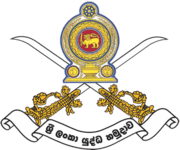 Emblem of the Sri Lanka Army | |
| Founded | April 1, 1881[1] |
| Country | |
| Type | Army |
| Role | Foreign and Domestic Defence |
| Size | 250,000[2] |
| Part of | Sri Lankan Armed Forces |
| Headquarters | Defence Headquarters Complex |
| Motto(s) | Latin: Pro Patria "For the Fatherland" |
| Colours | Gold, blue and orange |
| Anniversaries | Army Day: 1 April |
| Engagements | World War II 1971 JVP Insurrection 1987–89 JVP Insurrection Sri Lankan Civil War |
| Decorations | Military awards and decorations of Sri Lanka |
| Website | www |
| Commanders | |
| Commander-in-Chief | President Lieutenant colonel Gotabaya Rajapaksa |
| Commander of the Army | Lieutenat General Shavendra Silva, WWV, RWP, RSP, VSV, USP |
| Chief of Staff of the Army | Major General Jagath Gunawardena, RSP, VSV, USP |
| Deputy Chief of Staff of the Army | Major General Rasika Fernando |
| Notable commanders | Field Marshal Sarath Fonseka General Sepala Attygalle General Hamilton Wanasinghe Lieutenant General Denzil Kobbekaduwa Major General Vijaya Wimalaratne Major General Bertram Heyn Major General Anton Muttukumaru |
| Insignia | |
| Flag | |
| Presidential Colour | 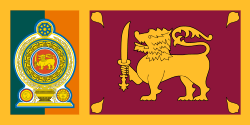 |
| Sri Lanka Army |
|---|
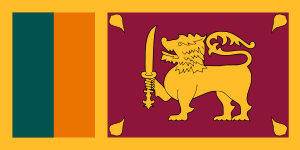 |
| Components |
| History |
| Equipment |
| Personnel |
| Welfare |
|
The professional head of the Sri Lanka Army is the Commander of the Army, currently Lieutenant General Shavendra Silva.[6][7] The Commander-in-Chief of the Sri Lankan Military is the President of Sri Lanka, who heads the National Security Council through the Ministry of Defence, which is the highest level of military command charged with formulating, executing defence policy and procurements for the armed forces.[8] However operations of the Sri Lanka Army are coordinated by the Joint Operations Command, with other two armed forces.
History
Ancient and pre-colonial times
The first military engagements in Sri Lankan history were marked by the advent of King Vijaya, a Bengal prince who landed along with his followers on the beaches of northwestern Sri Lanka around 543 BC. Prince Vijaya and his followers occupied the lands of the native Veddah people. Repeated incursions by South Indians, particularly the Cholas, into Sri Lankan territory occurred throughout the next few centuries and led to the engagement of the rival forces in battle.[9] In one famous encounter, Sinhalese King Dutugemunu (200 BC) raised an army of eleven thousand in his battle against the Chola invader King Elara, whom he eventually defeated. King Dutugemunu's organisational skills, bravery and chivalry are famous and his battles have gone down in history as outstanding offensive operations.[10]
Other Sri Lankan rulers whose military achievements stand out include King Gajabâhu (113 AD), who sailed to India to bring back his captured soldiers, and King Dhatusena (433) who is credited with repulsing numerous Indian invasions and for organising a naval build-up to deter seaborne attacks. He also had the foresight to cover his defences with artillery. Vijayabâhu I (1001) was another warrior king who dislodged Indian invaders and united the country. Parakramabahu the Great (1153) was an outstanding monarch of the Polonnaruwa period of Sri Lankan history, and his accomplishments as a military leader and a great administrator are noteworthy. His reign included a military expedition to Burma (Myanmar) in retaliation for indignities inflicted on his envoys and Burmese interference in the elephant trade. This marked the first overseas expedition in Sri Lankan military history. It is also reported that Parakramabahu's fame was such that his assistance was sought by South Indian rulers who were involved in internecine struggles. Another strong ruler in the pre-colonial era was Parâkramabâhu VI, who defeated Indian invaders, united the island and ruled it from capital Sri Jayawardhanapura, Kotte.[10] Although the known epigraphical records do not indicate that the Sri Lankan rulers had a full-time standing army at their disposal, there is evidence supported by legend, designation, name, place and tradition that prove there were 'stand-by' equestrian, elephant, and infantry divisions to ensure royal authority at all times. Militias were raised as the necessity arose, and the soldiers returned to their pursuits, mainly for farming, after their spell of military duty.[10]
Colonial era
Parts of Sri Lanka came under the control of three colonial European powers, namely the Portuguese in the 16th century, the Dutch in the 17th century and the British in the 18th century. Yet, until the entire island was ceded to the British in 1815, regional kingdoms maintained most of their independent defense forces and were able to successfully repulse repeated thrusts by the European armies. However the British, unlike their counterparts, were not primarily restricted to maritime power, and thus had the capability to bring the entire island under their control and to integrate locals into the British defense forces.[10]
Portuguese and Dutch rule (1505–1796)
At the beginning of the 16th century, modern Europe first came in contact with Sri Lanka, which was then referred to as Ceylon. In 1505 a Portuguese fleet, while operating in the Indian seas against Arab traders, was blown off course and landed at Galle, on the southern coast of the island.[11] In 1517 the Portuguese re-appeared, and with the consent of the Sinhalese King established a trading post in Colombo. Having initiated contact with Sri Lanka as traders, the Portuguese soon made themselves political masters of the western seaboard. Numerous forts were soon established, and features of European civilisation was introduced.[10]
The Portuguese are credited with the introduction of European-style fortresses to Sri Lanka during this era. Although some locals already possessed military training and fighting experience, there is no evidence that the Portuguese employed local inhabitants into their own forces. Thus the Portuguese were forced to restrict their presence in the island due to their small numbers and their efforts were more focused toward projecting maritime power.[10]
In 1602 Dutch explorers first landed in Sri Lanka, which was then under Portuguese control. By 1658 they had completely ousted the Portuguese from the coastal regions of the island. Much like the Portuguese, they did not employ locals in their military and preferred to live in isolation, pursuing their interests in trade and commerce. Like the Portuguese, they defended their forts with their own forces, but unlike the Portuguese, Dutch forces employed Swiss and Malay mercenaries. The Dutch Forts in Jaffna, Galle, Matara, Batticaloa and Trincomalee were sturdily built and are considered a tribute to their military engineering skills. Also, like the Portuguese, the Dutch focussed on maritime power and although they had the capability to develop and use local forces, they chose to isolate themselves from the local population.[10]
British rule (1798–1948)
The British Empire then ousted the Dutch from the coastal areas of the country, and sought to conquer the independent Kandyan Kingdom. In the face of repeated British assaults, the Kandyans were forced into a degree of guerilla warfare and fared well against their superior British adversaries.[10]
Initially the British stationed their forces, which included naval vessels, artillery troops and infantry, to defend the island nation from other foreign powers, using the natural harbor of Trincomalee as their headquarters in Sri Lanka. In 1796, the Swiss and Malay mercenaries who were previously in the service of the Dutch were transferred to the British East India Company. While the Swiss Regiment de Meuron left in 1806 and was eventually disbanded in Canada in 1822, the Malays, who initially formed a Malay Corps, were converted into the 1st Ceylon Regiment in 1802 and placed under a British commanding officer. In the same year, the British became the first foreign power to raise a Sinhalese unit, which was named the 2nd Ceylon Regiment, also known as the Sepoy Corps.[10]
In 1803 the 3rd Ceylon Regiment was created with Moluccans and recruits from Penang. All these regiments fought alongside British troops in the Kandyan Wars which began in 1803. Throughout the following years, more Sinhalese and Malays were recruited to these regiments, and in 1814 the 4th Regiment was raised, which was composed entirely of African troops. It was later renamed as the Ceylon Rifle Regiment. Eventually, the Kandyan Kingdom was ceded to the British in 1815, and with that they gained control over the whole island. Resistance to British occupation cropped up almost instantly. During the first half-century of occupation, the British faced a number of uprisings, and were forced to maintain a sizable army in order to guarantee their control over the island. After the Matale Rebellion led by Puran Appu in 1848, in which a number of Sinhalese recruits defected to the side of the rebels, the recruitment of Sinhalese to the British forces was temporarily halted.[10]
Ceylon Light Infantry Volunteers
The second phase in the employment of non-British personnel commenced in 1881 after the enactment of an ordinance designed to authorise the creation of a Volunteer Corps in the island. It was designated the Ceylon Light Infantry Volunteers (CLIV). This move compensated for the disbandment of the Ceylon Rifle Regiment in 1874. The Ceylon Light Infantry Volunteers was originally administered as a single unit. However, over the years various sections of the volunteers grew large enough to become independent from their parent unit. The different units that emerged from the Volunteer Force were the
- Cadet Battalion Ceylon Light Infantry
- Ceylon Artillery Volunteers
- Ceylon Engineers
- Ceylon Mounted Infantry (CMI)
- Ceylon Planters Rifle Corps (CPRC).[10]
- Ceylon Supply & Transport Corps
- Ceylon Volunteer Medical Corps
Ceylon Defence Force

In 1910 the name of the military was formally changed to the Ceylon Defence Force (CDF). It continued to grow throughout the early period of the 20th century. The CDF saw active service when a contingent of the Ceylon Mounted Infantry (CMI) in 1900, and a contingent of the Ceylon Planters Rifle Corps (CPRC) in 1902, took part in the Second Boer War in South Africa. Their services were recognised by the presentation in 1902 of a colour to the CMI, and a presentation in 1904 of a banner to the CPRC. In 1922, the CDF was honoured by the presentation of the King's and Regimental colours to the Ceylon Light Infantry (CLI).[10]
During the First World War, many volunteers from the Defence Force travelled to Great Britain and joined the British Army, and many of them were killed in action. One of them mentioned by Sir Arthur Conan Doyle was Private Jacotine of the CLI, who was the last man left alive in his unit at the Battle of Lys,[12] and who continued to fight for 20 minutes before he was killed.[13]
In 1939, the CDF was mobilised and an enormous expansion took place which required the raising of new units such as the Ceylon Signals Corps, the Auxiliary Territorial Service (Ceylon) and also the Colombo Town Guard, which had been previously disbanded, but was later re-formed to meet military requirements. During the Second World War, Britain assumed direct control over the Armed Forces of Ceylon.[14]
Post-independence
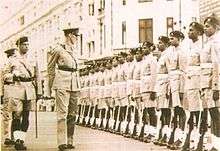
At the end of World War II, CDF which had increased in size during the war began demobilisation. In 1948 Sri Lanka gained independence from Britain, becoming a Dominion within the commonwealth and a year earlier Ceylon entered into the bi-lateral Anglo-Ceylonese Defence Agreement of 1947. This was followed by the Army Act No. 17 of 1949 which was passed by Parliament on April 11, 1949 and formalised in Gazette Extraordinary No. 10028 of October 10, 1949 marked the creation of the Ceylon Army, consisting of a regular and a volunteer force, the later being the successor of the disbanded CDF.[15][16] Therefore October 10, 1949 is considered the day the Ceylon Army was raised, and as such October 10 is celebrated annually as Army Day. Brigadier James Sinclair, Earl of Caithness was appointed as Commandant of the Ceylon Army. The Defence Agreement of 1947 provided the assurance that British would come to the aid of Ceylon in the event it was attacked by a foreign power and provided British military advisers to build up the country's military. In November, a Ceylon Army Guard takes over duties at Echelon Barracks from the Guard of the British Army.[17]
The Army Headquarters, Ceylon was established in Colombo, with a General Staff Branch, an Adjutant General Branch, a Quartermaster General Branch and a Pay and Records Branch. Soon after the Headquarters, Ceylon Volunteer Force was established. The initial requirement was to raise an artillery regiment, an engineer squadron, an infantry battalion, a medical unit, and a service corps company. For much of the 1950s the army was preoccupied with the task of building itself and training existing and new personal. To this aim the British Army Training Team (BATT) advisory group carried out training for ex-members of the CDF within the Ceylon Army, senior officers were sent to the British Army Staff College, Camberley and some attached to units of the British Army of the Rhine to gain field experience. New officers were sent for training at Royal Military Academy, Sandhurst, stating with 10 officer cadets in 1950, which continued until the 1968 and both officers and other ranks were sent to specialist training courses in Britain, India, Pakistan and Malaya. There were no formations and all units were structured to directly function under the Army Headquarters. However temporary field headquarters were to be formed at the time requirement arose.[16]
Due to a lack of any major external threats, the growth of the army was slow, and the primary duties of the army quickly moved towards internal security by the mid-1950s, the same time as the first Ceylonese Army Commander Major General Anton Muttukumaru took command of the army. The first internal security operation of the Ceylon Army began in 1952, code named Operation Monty to counter the influx of illegal South Indian immigrants brought in by smugglers on the north-western coast, in support of Royal Ceylon Navy coastal patrols and police operations. This was expanded and renamed as Task Force Anti Illicit Immigration (TaFII) in 1963 and continued up to 1981 when it was disbanded. The Army was mobilised to help the police to restore peace under provincial emergency regulations during the 1953 hartal, the 1956 Gal Oya Valley riots and in 1958 it was deployed for the first time under emergency regulations throughout the island during the 1958 Riots.[18]
During the 1950s and 1960s the army was called upon to carry to essential services when the workers went on strike which were organised by the left-wing parties and trade unions for various reasons, the most notable was the 1961 Colombo Port strike, during which ships threatened to bypass Colombo port and the country almost starved. To counter these common strikes several units were formed, who were employed in development work when there were no strikes. New regiments were formed, which included the Ceylon Armoured Corps, Ceylon Sinha Regiment and the Ceylon Pioneer Corps.[18]
In 1962 several volunteer officers attempted a military coup, which was stopped hours before it was launched. This attempted coup affected the military to a great extent, since the government mistrusted the military, it reduced the size and growth of the army, especially the volunteer force, with several units being disbanded and the new Gemunu Watch was formed.
1970–present

In 1971, the found itself facing a full blown insurgency, when the JVP Insurrection broke out in April 1971. Having being caught by surprise, as a result of failure to comprehend the magnitude of the insurgency from intelligence reports. Although completely ill-prepared to deal with an insurgency, lacking weapons, ammunition, equipment and training; the army responded quickly and successfully defeated the insurgency by the Janatha Vimukthi Peramuna by mid 1971.
In May 1972, when Ceylon was proclaimed a republic and changed its name from the Dominion of Ceylon to the Republic of Sri Lanka, all Army units were renamed accordingly.[19]
By the late 1970s the army was confronted with a new conflict, this time with Tamil militant groups in the north of the island. The Liberation Tigers of Tamil Eelam (LTTE) emerged as the prominent of these Tamil militant groups. The war escalated to the point where India intervened as a peacekeeping force. This was later seen as a tactical error, as the Indian Peace Keeping Force united nationalist elements such as the JVP to politically support the LTTE in their call to evict the IPKF. This led to a second insurgency by the JVP, forcing the army to deploy its forces in the south of the island and to fight on two fronts between 1987 and 1989. The 1980s saw a massive expiation of the army from 15,000 personal to over 30,000 and more. New regiments were raised, while others were expanded with new battalions. New weapons and equipment were introduced as the war shifted from counter-insurgency to conventional warfare tactics, with multi battalion, brigade and division scale operations. New regiments were formed which included the Commando Regiment, Special Forces Regiment, Mechanized Infantry Regiment, Gajaba Regiment, Vijayabahu Infantry Regiment, Military Intelligence Corps, Sri Lanka Army Women's Corps, Sri Lanka Rifle Corps and the Sri Lanka National Guard.
The war with the LTTE was halted several times for peace negotiations, the last of which following the signing of a ceasefire agreement in 2002 with the help of international mediation. However, renewed violence broke out in December 2005 and following the collapse of peace talks, the Army has been involved in the heavy fighting that has resumed in the north and east of the country.
Since 1980 the army has undertaken many operations against the LTTE rebels. The major operations conducted by the army eventually led to the recapture of Jaffna and other rebel strongholds. On 19 May 2009 Sri Lankan army declare the victory of war as they found the dead body of LTTE leader Velupillai Prabhakaran. This marked the end of the war, with the LTTE ceasing to exist in Sri Lanka as a result of prolonged military offensives conducted by Sri Lanka army.[20] The Sri Lankan Armed Forces, including the army, have been accused of committing war crimes during the war, particularly during the final stages.[21][22] A panel of experts appointed by UN Secretary-General Ban Ki-moon to advise him on the issue of accountability with regard to any alleged violations of international human rights and humanitarian law during the final stages of the civil war found "credible allegations" which, if proven, indicated that war crimes and crimes against humanity were committed by the Sri Lankan Armed Forces and the Tamil Tigers.[23][24][25]
Major combat operations
|
|
|
Peacekeeping
The Sri Lanka Army has taken part in two peacekeeping missions with United Nations over the course of its history. First assignment was in the Congo (ONUC) (1960–1963). Most recently, following the signing of a ceasefire agreement was signed between the government and the LTTE in 2002, Sri Lankan forces were invited by the United Nations to be part of the UN peacekeeping force in Haiti. In the process of the peacekeeping operations, two soldiers were killed in a raid in Petit-Goave.[26] After over 6 months of service, the first contingent of the peacekeeping force returned to Sri Lanka on May 17, 2005.[27] In December 2007, 7th rotation of the Sri Lankan contingent had been deployed with a force of 991 officers and other ranks, many of those deployed have been awarded the United Nations Medal for their services.[28] In November 2007, 114 members of the 950 member Sri Lankan Army peacekeeping mission in Haiti was accused of sexual misconduct and abuse[29][30] which resulted in 108 members, including three officers, being sent back after being implicated in alleged misconduct and sexual abuse where sex was exchanged for money and valuable items, with some acts considered rape as they involved those under 18.[31][30][32][33] In January 2019, a Sri Lankan army officer and trooper on peace keeping duty in Mali were killed and three more wounded when their convoy came under an IED attack.[34] The incident prompted the army to accelerate its Avalon program.[35]
Current deployments

As of present, the bulk of the Sri Lankan Army is deployed for domestic defensive and combat operations, while a sizable foreign deployment is maintained.
Domestic
Due to the Sri Lankan Civil War the army has been on a constant mobilized (including reservist) state since the 1980s (except for a brief period from 2002 to 2005). The majority of the army has been deployed in the North and Eastern provinces of the country, which includes 14 Divisions coming under six operational headquarters and 2 independent Divisions and several independent Brigades. The army is also based in other parts of the island for internal security including a Division for the defence of the capital.
Foreign
The Sri Lanka Army currently participates in several major overseas deployments:
- Haiti – an infantry battalion with support personal totaling around 1000 personal in Haiti as part of the United Nations Stabilization Mission in Haiti from 2004 to 2015.[36]
- Chad – a contingent of engineers joined the United Nations Mission in the Central African Republic and Chad on May 25, 2010.[37][38]
- Lebanon – a mechanized infantry company with combat support personal in the United Nations Interim Force in Lebanon since November 2010.[39]
- South Sudan – Sri Lanka Army's entry into South Sudan in 2014 as the newest member in the UN peace keeping family, marks a milestone in the Army history. Sri Lanka became the first country to deploy a surge contingent in South Sudan.Army maintains a SRIMED Level 2 Hospital, manned entirely by Sri Lanka's Sri Lanka Army Medical Corps personnel.[40][41]
- Mali – an infantry battalion with support personal will be deployed as part of the United Nations Multidimensional Integrated Stabilization Mission in Mali in 2016[42]
Organization structure
The professional head of the army is the Commander of the Army, at present Lieutenant General Shavendra Silva. He is assisted by the Chief of Staff of the Sri Lanka Army and a Deputy Chief of Staff. The Commandant of the Volunteer Force is head of the Army Volunteer Force and is responsible for the administration and recruitment of all reserve units and personal. The Army Headquarters, housed in the Defence Headquarters Complex in Sri Jayawardenapura Kotte is the main administrative and the operational headquarters of the Sri Lanka Army.[43]
Administrative
The Army Headquarters is divided into a number of branches, namely the General Staff (GS) branch responsible for coordination of operations and training and the Adjutant General's (AGs) branch responsible for personal administration, welfare, medical services, and rehabilitation. The Quarter Master General's (QMGs) branch is responsible for feeding, transport, movement, and construction and maintenance. The Master General of Ordnance's (MGOs) branch is responsible for procurement and maintenance of vehicles and special equipment.[44] The Military Secretary's Branch is responsible for handling all matters pertaining to officers such as promotions, postings and discipline. Each branch is headed by an officer in the rank of Major General who is directly responsible to the Commander of the Army for the smooth functioning of the Branch. Under each Branch, there are several Directorates, each headed by a Brigadier.[44]
The headquarters of field formations each have its own staff. For instance a divisional headquarters is divided into a GS branch as an AQ branch, each headed by a Colonel and is responsible for operations & training and administration & logistics respectively. Similarly, a Brigade Major and Major AQ is responsible for operations and administration in a brigade.[44]
Like the Indian Army, the Sri Lanka Army has largely retained the British-style regimental system that it inherited upon independence. The individual regiments (such as the Sri Lanka Light Infantry and the Sinha Regiment) operate independently and recruit their own members. Officers tend to remain in a single battalion throughout their careers. The infantry battalion, the basic unit of organization in field operations, includes five companies of four platoons each. Typical platoon has three squads (sections) of ten personnel each. In addition to the basic infantry forces, a commando regiment was also established in 1986. Support for the infantry is provided by an armoured regiment, five reconnaissance regiments, three mechanized infantry regiments, five field artillery regiments, a rocket artillery regiment, three commando regiments, three special forces regiments, six field engineering regiments, five signals battalions, a medical corps, and a variety of logistics units.[45]
Regiments and corps
| Name | Headquarters | Subunits |
|---|---|---|
| Armoured Corps | Rock House Army Camp, Colombo | Eight regular regiments and a volunteer regiment. |
| Artillery | Panagoda Cantonment, Panagoda | Ten regular regiments and two volunteer regiments. |
| Engineers | Army Headquarters, Colombo | Six regular regiments and one volunteer regiment. |
| Signals Corps | Panagoda Cantonment, Panagoda | Ten regular regiments and one volunteer regiment. |
| Light Infantry | Panagoda Cantonment, Panagoda | Seventeen regular battalions, Nine volunteer battalions. |
| Sinha Regiment | Ambepussa Camp, Ambepussa | Seven regular battalions, five volunteer battalions and a headquarters battalion. |
| Gemunu Watch | Kuruwita Army Camp, Ratnapura | Nine regular units, four volunteer units. |
| Gajaba Regiment | Saliyapura Camp, Anuradhapura | Twelve regular battalions and five volunteer battalions. |
| Vijayabahu Infantry Regiment | Boyagane Camp, Kurunegala | Eight regular battalions and four volunteer battalions. |
| Mechanized Infantry Regiment | N/A | Four regular battalions and one volunteer battalion. |
| Commando Regiment | Ganemulla, Gampaha | Four regular regiments. |
| Special Forces Regiment | Seeduwa, Negombo | Three regular regiments. |
| Military Intelligence Corps | Polhengoda, Colombo | Two regular battalions. |
| Engineer Services Regiment | Panagoda Cantonment, Panagoda | Three regular regiments and a volunteer regiment. |
| Service Corps | Panagoda Cantonment, Panagoda | Six regular units and one volunteer unit. |
| Medical Corps | Panagoda Cantonment, Panagoda | Four regular units and one volunteer unit. |
| Ordnance Corps | Panagoda Cantonment, Panagoda | Three regular ordnance battalions and one volunteer ordnance battalion. |
| Electrical and Mechanical Engineers | Slave Island, Colombo | Seven regular regiments and one volunteer regiment. |
| Corps of Military Police | Polhengoda, Colombo | Six regular regiments. |
| General Service Corps | Panagoda Cantonment, Panagoda | Three regular unit and a volunteer unit. With 3 & 4 SLAGSC (Pay & Records) |
| Women's Corps | Regtl Centre, Borella | Two regular units and 5 volunteer units. |
| Rifle Corps | Army Headquarters, Colombo | Two volunteer battalions. |
| Pioneer Corps | Headquarters, Battharamulla, Pelawatta. | One volunteer unit. |
| National Guard | Kurunegala | 32 volunteer battalions. |
Operational command
Organized and controlled by the Army General Staff at Army HQ, various formations are raised from time to time to suit various security requirements and operations in the country and overseas. The Army at present has deployed 12 Divisions, 7 task forces and several independent brigades. Except for the 11 Division based at the Panagoda Cantonment which is responsible for the maintenance of capability for the defense of the capital, all other divisions, task forces and brigades are deployed for operations in the Northern and Eastern provinces of Sri Lanka, coming under six regional commands known as Security Forces Headquarters, which are the Security Forces Headquarters Jaffna (SFHQ-J), Wanni (SFHQ-W), East (SFHQ-E), Kilinochchi (SFHQ-KLN), Mullaittivu (SFHQ-MLT), West (SFHQ-W) and Central (SFHQ-C)
Each SFHQ and most divisions are commanded by a General Officer Commanding in the rank of Major General. A SFHQ has several divisions under its command and each division is further divided into brigades. Each brigade is commanded by an officer in the rank of Brigadier and has a number of Infantry battalions, support arms (Artillery, Engineers and Signals) and support services (Service Corps, Engineering Services, Ordnance Corps, Electrical and Mechanical Engineers) under assigned to it. There are also several independent brigade (Air Mobile Brigade, Armored Brigade, etc.)
In other parts of the country, there are Area and Sub-Area Headquarters. Armour, Artillery, Engineers and Signals Units are grouped under Brigade Headquarters of their own arm; Armored Brigade, Artillery Brigade and so on.
Force formations
- Security Forces Headquarters - Jaffna (SFHQ-J)
- 51 Division, based in Jaffna
- 52 Division, based in the Jaffna Peninsula
- 55 Division, based in Elephant Pass Military Base, Jaffna Peninsula[46]
- Security Forces Headquarters - Wanni (SFHQ-W)[46]
- Area Headquarters Mannar, Mannar
- 56 Division, operating in the Vavuniya District
- 61 Division, operating in the Vavuniya District
- 21 Division
- 54 Division
- 62 Division
- Security Forces Headquarters - East (SFHQ-E)
- 22 Division, based in Trincomalee[47]
- 23 Division, based in Poonani, Batticaloa District[48]
- 24 Division
- 57 Division, operating in the Kilinochchi District
- 66 Division, operating in the Kilinochchi District
- 68 Division, operating in the Kilinochchi District
- Affiliated Units
- FMA Units
- 59 Division, operating in the Mullaittivu District
- 64 Division, operating in the Mullaittivu District
- 68 Division, Kombavil, Mullaittivu District
- Task Force 2, operating in the Mullaittivu District
- 14 Division, based in Colombo, Western Province
- 141 Brigade, based in Gampaha
- 142 Brigade, based in Colombo and Kalutara
- 143 Brigade, based in Puttalam and Kurunegala
- 58 Division
- 11 Division
- 14 Division
- Independent Divisions
- 53 Division, based at Mankulam[46]
- Independent Brigades
- Air Mobile Brigade
- Armored Brigade
- Artillery Brigade
- Commando Brigade
- Engineer Brigade
- Mechanized Infantry Brigade
- Signals Brigade
- Special Forces Brigade
Training
The Army Training Command (ARTRAC) with its headquarters at Diyatalawa formulates all training doctrine of the army and all its training centers. ARTRAC directs all army training establishments, regimental training establishments and battalion training schools.[51]
General Sir John Kotelawala Defence University (KDU) formed in 1981 and situated in Ratmalana, fourteen kilometers south of Colombo, is Sri Lanka's only university specializing in defence studies. Each year, approximately fifty cadets from all three services are admitted to the university (aged 18–22) to participate in a three-year programme of academic work and basic training.[44][45]
Junior field officers of the army and their counterparts in the Navy and Air Force follow the Command and Staff Course at the Defence Services Command and Staff College (DSCSC) at Batalanda, Makola which was established in 1997 as the Army Command and Staff College and the Junior Staff Course at the Officer Career Development Centre. While the Logistics Staff Course is conducted at the Army School of Logistics which was established in 2011. In addition KDU conducts Masters Of Science (Defence Studies) degree for the officers of army. The army continuous to send its senior officers for overseas training, specially for defense college.
Basic officer training is carried out at the Sri Lanka Military Academy (SLMA) (formally the Army Training Centre) situated in Diyatalawa, in the Badulla District. The officer cadets graduating from the academy are commissioned as officers in the regular and volunteer forces. The course for officer cadets runs for ninety weeks and includes training in tactics and administration which helps prepare the cadets to take up the positions of platoon commanders. The course consisted of military and academic subjects and also trained the cadets physically. The course helps to promote leadership qualities and the understanding of each one's role as an officer and a servant of the state. Due to the lack of officers within the lower levels, the training process was sped up in the 1980s by developing a short commission course. The cadets were given a training of fifty-six weeks and devoted themselves to continue their careers in the military with the ten years of service for regular army officers and five years of service for volunteer officers.
Training for the new recruits are carried out by the Army Training School in Maduru Oya and at several locations by training battalions, followed by additional specialized training (both officers and other ranks) at the Infantry Training Centre in Minneriya, the Combat Training School in Ampara, while non-commissioned officers receive training at the Non-commissioned Officers Training School at Kala Oya. All these establishments come under the control of the Directorate of Training, Army Headquarters. Specialist and additional training is given by specialist training schools, regimental training centres and individual field units.[44][45]
At its formation the armed forces of Sri Lanka had limited indigenous training facilities, especially in technical and advanced roles, they have depended greatly on military training provided by foreign countries. The United Kingdom played a major role in the early years following independence and have continued to be an important source of military expertise to the Sri Lankan military. Other sources include India, Pakistan, the United States, Australia and Malaysia. Additionally, in an agreement reached in 1984, Israeli security personnel (reportedly from Shin Bet, the Israeli counterespionage and internal security organisation) trained army officers in counterinsurgency techniques. With the rapid expansion of the army, in recent years it has expanded its training facilities locally.[45]
The Sri Lankan Army has also provided special training to the United States Army on their request as well as many other countries in military education regarding civilian rescue, jungle combat, and guerilla warfare etc.[52]
Training establishments
|
Training Centres[53]
|
Regimental Training Centers[53]
|
Personnel
The Sri Lanka Army presently stands at 200,000 strong[54] including 2,960 women plus and 58,000 reservists.[55]
In late 1987, the army had a total estimated strength of up to 40,000 troops, about evenly divided between regular army personnel and reservists on active duty. The approximately 20,000 regular army troops represented a significant increase over the 1983 strength of only 12,000. Aggressive recruitment campaigns following the 1983 riots raised this number to 16,000 by early 1985.[45] By 1990 the army had expanded to over 90,000 personnel and by 2007, it had expanded to over 120,000.[3]
Since the Sri Lankan armed forces are all volunteer services, all personal in the Sri Lanka Army have volunteered as regular personnel or reservists. This should not be confused with the traditional term volunteers used for reservists or reservist units. Recruitment of the personal are carried island wide with a restrictions in the northern and eastern provinces during the civil war in those areas. The Rifle Corps is the only territorial unit that carries out recruitment from a specific area. In June 2009, Sri Lanka announced plans to create a "Tamil regiment" to promote integration in the army.[56]
Rank of Field Marshal
In the year 2015, Sri Lanka Army got is 1st Rank of Field Marshal, when President Maithripala Sirisena promoted General Sarath Fonseka to the post. Field Marshal Fonseka is well known for leading the 30-year-old war to an end.[57][58]
Parama Weera Vibhushanaya recipients
The Parama Weera Vibhushanaya is the highest award for valour awarded in the Sri Lankan armed forces. Army recipients include;
- Colonel A.F. Lafir †
- Lieutenant-Colonel Lalith Jayasinghe †
- Major G. S. Jayanath †
- Major K. A. Gamage †
- Captain Saliya Upul Aladeniya †
- Captain H. G. M. H. I. Megawarna †
- Lieutenant U. G. A. S. Samaranayake †
- Second Lieutenant K.W.T. Nissanka †
- Warrant Officer 2nd Class Pasan Gunasekera †
- Staff Sergeant H. G. S. Bandara †
- Sergeant D. M. S. Chandrasiri Bandara †
- Sergeant P.N. Suranga †
- Corporal Gamini Kularatne †
- Corporal K. Chandana †
- Corporal P. M. Nilantha Pushpa Kumara †
- Corporal A. M. N. P. Abesinghe †
- Lance Corporal W. I. M. Seneviratne †
- Lance-Corporal T. G. D. R. Dayananda †
- Lance-Corporal R. M. D. M. Rathnayake †
- Lance-Corporal A. M. B. H. G. Abeyrathnebanda †
Notable fallen members
Over 23,790 Sri Lankan armed forces personnel were killed since begin of the civil war in 1981 to its end in 2009, this includes 12 general officers killed in active duty or assassinated.[59] 659 service personnel were killed due to the second JVP insurrection from 1987 to 1990. 53 service personnel were killed and 323 were wounded in the first JVP insurrection from 1971 to 1972.[60] Notable fallen members includes;
- Lt. General Denzil Kobbekaduwa † – One of the greatest generals in modern Sri Lanka and Overall Operations Commander, Northern Sector.[61]
- Lt. General Parami Kulatunga † – Former Deputy Chief of Staff of the Army.[61]
- Lt. General Nalin Angammana † – Former GOC 3 Division.[62]
- Maj. General Vijaya Wimalaratne † – Jaffna Brigade Commander & One of the greatest generals in modern Sri Lanka.[61]
- Maj. General Lakshman 'Lucky' Wijayaratne † – Former brigade commander, 22 Brigade.[62]
- Maj. General Percy Fernando † – Former deputy GOC 54 Division.[62]
- Maj. General Larry Wijeratne † – Former brigade commander, 51-4 Brigade.[62]
- Maj. General Susantha Mendis † – Former brigade commander, 51-2 Brigade.[62]
- Maj. General Janaka Perera – Former Chief of Staff of the Sri Lanka Army, Overall Operations Commander Northern Sector, General Officer Commanding (GOC) of the 53 Division.
- Maj. General Ananda Hamangoda † – Former brigade commander, 51-2 Brigade.[63]
- Brigadier Ariyasinghe Ariyapperuma † – Former Commander, Northern Command
- Brigadier Bhathiya Jayatilleka † – former Brigade commander, 54-1 brigade
- Brigadier Rohitha Neil Akmeemana † – former Brigade commander, Elephant Pass.[62]
- Colonel Tuan Nizam Muthaliff † – Former commanding officer 1st Battalion Military Intelligence Corps.[64]
- Major Noel Weerakoon † – first army officer killed in action (during the 1971 Insurrection)
Directorate of Rehabilitation
The Directorate of Rehabilitation was established with the intention and focus towards the rehabilitation of Officers and Other Ranks Wounded in Action. However, with the increase of a number of casualties due to the operations, the Sri Lanka Army proceeded to utilize the services of battle casualties with the view of obtaining a productive service from these individuals. As a result, under mentioned institutes had been established.[65]
- Ranaviru Sevana.
- Ranaviru Apparels.
- Abimansala Wellness Resort 1 (Anuradahapuru).
- Abimansala Wellness Resort 2 (Kamburupitiya).
- Abimansala Wellness Resort 3 (Pangolla)
- Ranaviru Resources Centre.
- Mihindu Seth Medura.
Women in the Sri Lanka Army
Making a corps for women was dreamed by former Commander of the Army Lt. General Denis Perera who became commander in October 1977. Perera sought help from the WRAC of British Army and in 1978 three females were sent to Britain for officer training. They returned to Sri Lanka in August 1979 after completion of eight months of training. The corps was officially formed on September 14, 1979 with one battalion (the 1st regular battalion).
The first three female cadets to enroll the army were KC Jayaweera, MP Wijegunawardena and VP Senevitathna (trained in Britain) and the first batch of female cadets to be trained in Sri Lanka was commissioned from the Sri Lanka Military Academy on 18 August 1984.[66] On 16 October 1980, ten women were recruited for NCO training and were given the basic Army training at the Army Training Centre, Diyatalawa. These NCOs passed out in November 1980. The three officers and ten NCOs participated at the Independence Day celebrations held at the Galle Face Green for the first time in 1981 and Women's Corps has been a part of the country's Independence celebrations ever since.[66] Lieutenant Colonel (later Brigadier) AW Thambiraja (male) was the first Commanding Officer of the 1st regular battalion (1 SLAWC) and Major K.C Weerasekara was promoted to Lt. Col. in 1993; she was the first woman to be promoted to this rank from this corps and was also the first woman to be appointed as the commanding officer of the 1 SLAWC in 1989 in the rank of Major.
The regimental centre of the corps was established on 17 November 1997 at Borella. Male Major General W.A.A. de Silva RSP USP was the first Colonel Commandant of the Regiment and female Lieutenant Colonel M.H.P.S. Perera, USP was the first Centre Commandant. Major General H.I.G. Wijerathna, USP was the first female colonel commandant of this regiment who served from 2008 to 2010 and Brigadier D.T.N. Munasinghe was the second female to be appointed as the colonel commandant in 2016.[67][68][69]
The primary aim of raising Women's Corps was to provide telephone operators, computer operators, nurses and clerks, to release the male counterparts to the battle field. However, women soldiers were also employed on field duties later.[70][71] Six more battalions were created in the 1990s and 2000s and till now the corps has seven battalions in total.
Equipment
In the 1980s, the army expanded its range of weapons from the original stock of World War II-era British Lee–Enfield rifles, Sten Submachine guns, Vickers machine guns, Bren machine guns, 6-inch coastal guns, Daimler Armoured Cars, Bren Gun Carriers,[72] 40 mm anti-aircraft guns, 3.7-inch heavy anti-aircraft guns and 4.2-inch heavy mortars as well as post war Alvis Saladins, Alvis Saracen, Ferrets and Shorland S55s. New sources of weaponry in the mid-to-late 1970s included the Soviet Union, Yugoslavia, and China – countries with which the leftist Bandaranaike government had close ties. China continued to be an important source of arms well into the 1990s.[45]
To meet the threat posed by predominantly the LTTE, Army purchased modern military hardware including 50-caliber heavy machine guns, rocket-propelled grenade (RPG) launchers, Night Vision Devices, 106 mm recoilless rifles, 60 mm and 81 mm mortars, 40 mm grenade launchers and some sniper rifles. Refurbished armored personnel carriers were added to the 'A' vehicle fleet of the 1st Reconnaissance Regiment, Sri Lanka Armoured Corps. These APCs enabled the Armoured Corps to have their own assault troops to provide close contact protection to their Alvis Saladin and Ferret Scout Cars which were vulnerable to anti-tank weapons. The capability of the Sri Lanka Artillery was enhanced with the introduction of Ordnance QF 25 pounders.[45][73] Chinese-made 122 mm, 130 mm and 152 mm howitzers were introduced to the Sri Lankan Army in 1995 and 1998 whilst 122 mm Multi Barrel Rocket Launchers (MBRL), were first used in 2000 by the Sri Lanka Army.[74]
Though the weapons were obsolete at the time of purchase, security forces found them to be successful in combat. Land mines proved to be the most lethal threat to personnel, as a number of mines were deployed against unprotected trucks and buses by the LTTE in the northern and eastern Provinces. These land mines weighed approximately 50 – 100 kg, against which no armoured vehicle that the SLA possessed was able to withstand the blast effect. Consequently, Armscor Buffels – South African armoured personnel carriers constructed on a Unimog chassis – were imported in quantity. By 1987 Sri Lanka's indigenous Unicorn APC had been engineered from the Buffel, followed by the improved Unibuffel class.[75] Both the Unicorn and the Unibuffel are assembled by the Sri Lanka Electrical & Mechanical Engineers.[45][73]
In recent years, Sri Lanka has become increasingly reliant on China for weapons.[76] This is due to most European nations and the United States Governments passing regulations about the selling of weaponry to nations which are suffering from internal conflict.[77] However, in light of recent attacks by the LTTE, the United States has expressed its intent to maintain military training assistance and possibly increase it should the violence continue.
Sri Lanka also continues to receive a variety of weapons from Britain, India, Japan, Pakistan, Israel and other former suppliers.[76][78]
Armour

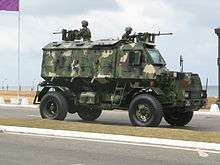
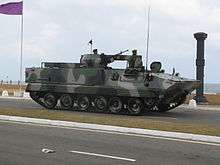
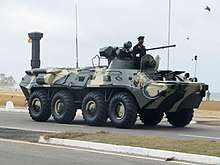

| Type | Origin | Quantity | Notes |
|---|---|---|---|
| Main Battle Tanks | |||
| T-55AM2 | 82[79] | ||
| Type 69 | 30+[80] | In reserve | |
| Type 59 | 90+ | In reserve | |
| Light Tanks | |||
| Type 63 | N/A | Amphibious, mostly in reserve | |
| Infantry fighting vehicles | |||
| BMP-3 | 50[81] | ||
| BMP-2 | 52[79] | ||
| BMP-1 | 15[79] | ||
| Armoured Cars | |||
| Land Rover Hotspur | |||
| Armoured personnel carriers | |||
| Type 89 (YW534) | 15+[82] | Tracked | |
| Type 85 (YW531H) | 32+ | Tracked, Amphibious | |
| Type 63 (YW531) | 20+[83] | Tracked | |
| BTR-80 | 25[79] | wheeled | |
| Type 92 (WZ551) | 200 | wheeled | |
| Unibuffel | 60+ | Locally manufactured, Mine-protected APC | |
| Unicorn | 70+ | Locally manufactured, Mine-protected APC | |
| Buffel | 31[79] | Mine-protected APC | |
| Engineering Support Vehicles | |||
| VT-55 | 18+[84] | Armoured recovery vehicle | |
| MT-55A | 14+[85] | Armoured vehicle-launched bridge | |
Artillery

| Type | Origin | Quantity | Notes |
|---|---|---|---|
| Rocket artillery | |||
| RM-70 Multiple rocket launcher | 22[79] | ||
| Towed artillery | |||
| Type 56 85 mm field gun | N/A[79] | 85 mm field gun | |
| Type 66 152 mm gun-howitzer | 40[79] | 152 mm gun-howitzer | |
| Type 59 130mm field gun | 40[79] | 130 mm field gun | |
| Type 60 122mm howitzer | 74[79] | 122 mm howitzer | |
| Ordnance QF 25 pounder | N/A | field guns – Ceremonial Gun Troop | |
| 76 mm mountain gun M48 | N/A | ||
| Mortars | |||
| M-43 | 55[79] | 160 mm heavy mortar | |
| Type 86 (W86) | 55 | 120 mm towed mortar | |
| Type 84 (W84) | N/A | 82 mm mortar | |
| Type 89 (W89) | N/A | 60 mm light mortar | |
| Weapon Locating Radar | |||
| AN/TPQ-36 Firefinder Radar | N/A | Weapon Locating and Counter-battery Radar | |
| SLC-2 Radar | N/A | ||
Infantry weapons
|
|
Welfare
Sri Lanka Army Seva Vanitha Unit
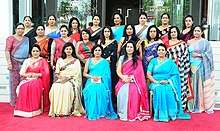
Inaugurated on 12 July 1984,[92] Sri Lanka Army Seva Vanitha Unit[93] functions with the main objective of providing welfare facilities to the next of kin of war heroes who have sacrificed their lives, gone missing in action or injured whilst defending the sovereignty and territorial integrity of their motherland while also empowering the families of the serving Army personnel. Traditionally the organization functions under the leadership of the wife of the serving Commander of the Army, and the members are the spouses of Army Officers as well as Lady Officers. The organization extends to 22 Regimental branches[94][92] functioning under the patronage of the wives of the respective Regimental Commanders.
Sri Lanka Army Seva Vanitha Unit conducts various welfare projects such as Viru Kekulu pre-schools, day care centres, welfare shops, bakeries and salons,[95] with the committed contribution of the dedicated membership. Construction of houses, giving away of educational scholarships and assisting in times of natural disasters, are done at both organizational and Regimental levels. The volunteer service extended by the spouses of the Army Officers whilst multitasking at their roles as wives, mothers and professionals, is an immense strength to Sri Lanka Army.[95]
Gallery
- Sri lanka Army
- SLA HJ-8.
 BMP-2 Infantry Fighting Vehicle
BMP-2 Infantry Fighting Vehicle
 SLA Unibuffel.
SLA Unibuffel.- SLA MIR weapons
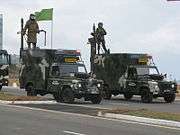 SLA Bomb Disposal Units on Victory Day Parade.
SLA Bomb Disposal Units on Victory Day Parade.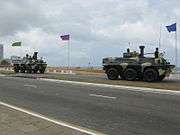 WZ551 (Type 92) Armoured Personnel Carriers.
WZ551 (Type 92) Armoured Personnel Carriers.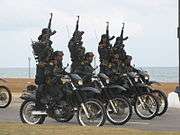 Combat Rider Teams, Special Forces Regiment
Combat Rider Teams, Special Forces Regiment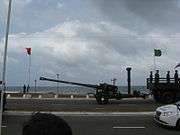 Artillery Units
Artillery Units Artillery Units
Artillery Units
See also
- Awards and decorations of the military of Sri Lanka
- Uniforms of the Sri Lanka Army
- Military ranks and insignia of the Sri Lanka Army
Further reading
- Army, Sri Lanka. (1st Edition – October 1999). Sri Lanka army: 50 years on, 1949–1999 ISBN 978-955-8089-02-6
References
- Sri Lanka Light Infantry
- "Security News – Sundayobserver.lk – Sri Lanka". sundayobserver.lk. Archived from the original on 29 July 2010. Retrieved 25 July 2016.
- "Country Reports on Human Rights Practices – 2000". U.S. State Department. February 23, 2001. Archived from the original on June 7, 2001. Retrieved 2007-03-23.
- "The Island – News". Retrieved 6 February 2015.
- "Deadly arsenals dot Sri Lanka". Richard M Bennett. Asia Times Online. 5 August 2006.
- "Mahesh Senanayaka new Army Commander". www.dailymirror.lk.
- http://www.defence.lk/new.asp?fname=Lieutenant%20General%20Mahesh_Senanayake_appointed_as_new_Army_Commander_20170704_01
- "Commander-in-Chief Completes One Year in Office". Media Center for National Security. 2007-03-08. Archived from the original on 2007-09-28. Retrieved 2007-04-20.
- "Sri Lanka Army History, The Ancient Time". Sri Lanka Army. Archived from the original on 2007-02-02. Retrieved 2007-02-04.
- Army, Sri Lanka (October 1999). "Chapter 1". Sri Lanka Army, "50 YEARS ON" – 1949–1999 (1st ed.). Colombo: Sri Lanka Army. pp. 1–3. ISBN 978-955-8089-02-6.
- "The Portuguese in Sri Lanka (1505–1658)". WWW Virtual Library – Sri Lanka. Retrieved 2004-06-30.
- Doyle, Arthur Conan, 1859-1930,. The Great War : the British campaign in France and Flanders. Volume 1. [LONDON, England]. ISBN 978-1-78394-624-2. OCLC 865473156.CS1 maint: extra punctuation (link) CS1 maint: multiple names: authors list (link)
- "Indias.com, Sri Lankan Army". Indias. Retrieved 2006-02-04.
- "History of the Sri Lanka Light Infantry Regiment, Sri Lanka Army". Sri Lanka Army. Archived from the original on 2006-07-08. Retrieved 2006-02-04.
- "Establishment, Sri Lanka Army". Sri Lanka Army. Archived from the original on 2006-03-26. Retrieved 2006-02-04.
- "Sergei de Silva-Ranasinghe looks back at the early days of the Sri Lanka Army". Retrieved 6 February 2015.
- 1950 Fergusons Ceylon Directory. Colombo: Fergusons.
- "An evolving army and its role through time, Sergei de Silva- Ranasinghe's article on the early days of the Sri Lanka Army". Retrieved 6 February 2015.
- "Sri Lanka Army Marks 50 Years". Washingtonpost, AP News. October 10, 1999.
- Sri Lanka's Tamil Tigers admit defeat Christian Science Monitor – May 17, 2009
- "Rajapaksa vows to shield his army from international probe". The Indian Express. 27 May 2011.
- "Sri Lankan army agrees to probe war crimes". The Daily Telegraph. Agence France-Presse. 15 February 2012.
- "Report of the UNSG's panel of experts on accountability in SL". The Island, Sri Lanka. 16 April 2011.
- "UN panel admits international failure in Vanni war, calls for investigations". TamilNet. 16 April 2011.
- "Summary of UN Panel report". Daily Mirror (Sri Lanka). 16 April 2011.
- "2 U.N. peacekeepers killed in Haiti fighting". San Diego Union Tribune. March 21, 2005.
- "Sri Lanka Light Infantry UN Peacekeeping Operations". Sri Lanka Army. Archived from the original on 2007-02-04. Retrieved 2007-03-16.
- "Sri Lankan troops in Haiti honoured".
- Williams, Carol J. (2007-12-15). "U.N. confronts another sex scandal". Los Angeles Times. Retrieved 2008-11-07.
- "Sri Lanka to probe UN sex claims". BBC. 2007-11-03. Retrieved 2007-11-05.
- "Haiti: Over 100 Sri Lankan blue helmets repatriated on disciplinary grounds – UN". United Nations. 2007-11-02. Retrieved 2007-11-04.
- Reddy, B. Muralidhar (2007-11-05). "Part of Sri Lankan contingent in Haiti to be sent back". The Hindu. Retrieved 2007-11-05.
- "UN confirms sex charges". Sundaytimes. 2008-03-30. Retrieved 2008-03-30.
- "SL army contingent attacked in Mali; Two killed, three injured". www.dailymirror.lk.
- "New locally made MPV better at withstanding mines: SLEME | The Sunday Times Sri Lanka".
- "Haiti – MINUSTAH – Facts and Figures".
- "Sri Lanka Army – Defenders of the Nation". Retrieved 6 February 2015.
- "Ranil at Gangaramaya ::: Dailymirror.lk ::: Breaking News". Retrieved 6 February 2015.
- "The Island". Retrieved 6 February 2015.
- "Army's UN Peace-Keeping mission opens a new Hospital in South Sudan".
- "SL Army opens new hospital in South Sudan under UN Mission - South Sudan". ReliefWeb. Retrieved 2020-07-04.
- "SL Army contingent invited for UN Peacekeeping in Mali | The Sunday Times Sri Lanka".
- "Sri Lanka Army Establishment | Sri Lanka Army | Organization structure". www.army.lk. Retrieved 2020-07-04.
- "Military Balance, Sri Lanka". Institute of Peace and Conflict Studies. Archived from the original on 2006-10-02. Retrieved 2007-03-14.
- "Training | Sri Lanka Army". Sri Lanka Army. Retrieved 2020-07-04.
- "Two Security Forces Headquarters established in Mullaitivu, Kilinochchi". Archived from the original on September 16, 2011.
- "Security Forces on a realistic path to achieve the set target, Dailynews". Archived from the original on August 2, 2008.
- "Columns – Situation Report". Retrieved 6 February 2015.
- "Sri Lanka Army – Defenders of the Nation". Archived from the original on 6 February 2015. Retrieved 6 February 2015.
- "Sri Lanka Army – Defenders of the Nation". Archived from the original on 19 December 2014. Retrieved 6 February 2015.
- "Training | Sri Lanka Army". www.army.lk. Retrieved 2020-07-04.
- "Sri Lanka : Sri Lanka Army to train US Army". 15 May 2010. Retrieved 6 February 2015.
- "Training, Sri Lanka Army". Sri Lanka Army. Archived from the original on 2006-04-10. Retrieved 2006-02-04.
- "Almost A Decade After The End Of War- Sri Lanka Military Is The 20th Biggest In The World". Counterpoint. 2018-05-18. Retrieved 2020-07-04.
- "Sri Lanka". Nations Encyclopedia. Retrieved 2007-02-04.
- 'Tamil unit' for Sri Lanka's army BBC – June 29, 2009
- "President Promotes Sarath Fonseka To Rank Of Field Marshal". www.asianmirror.lk.
- "Sarath Fonseka to be bestowed with Field Marshal Title ::. Latest Sri Lanka News". March 20, 2015.
- "Victory's price: 6,200 Sri Lankan troops". News.smh.com.au. 22 May 2009. Retrieved 30 May 2009.
- "The Sunday Times – Special Assignment". Retrieved 6 February 2015.
- Kanagaraarachchi, Ramani (2007-01-20). "Heroes who made the supreme sacrifice". Daily News. Associated Newspapers of Ceylon. Archived from the original on 2007-09-30. Retrieved 2007-05-25.
- "Heroes who made the supreme sacrifice". Archived from the original on September 30, 2007.
- Ratnayake, Brigadier Daya (2005-07-30). "Noble in death as in life". The Sunday Times. Wijeya Newspapers Ltd. Retrieved 2007-08-18.
- De Silva, Senaka (2005-06-01). "Senior Army officer shot dead". Daily Mirror. Wijeya Newspapers Ltd. Archived from the original on 2007-09-30. Retrieved 2007-06-03.
- "Directorate of Rehabilitation" (PDF). About, Inc. Retrieved 2017-04-10.
- "History Of 1 SLAWC". alt.army.lk/slawc.
- "Newly-Appointed SLAWC Colonel Commandant Assumes Duties". alt.army.lk/slawc.
- "Sri Lanka Army Women's Corps, Sri Lanka Army". Sri Lanka Army. Archived from the original on 2007-01-28. Retrieved 2007-02-04.
- "Sri Lanka Army Women's Corps". army.lk. Retrieved 25 July 2016.
- "Sri Lankan Army Women's Corps". About, Inc. Retrieved 2007-02-04.
- "An officer and a lady: You've come a long way, lass". Sunday Observer. Retrieved 2006-10-08.
- Michael K. Cecil – Sri Lanka's Military: The Search For A Mission, .
- Army, Sri Lanka (October 1999). "Chapter 1". Sri Lanka Army, "50 YEARS ON" – 1949–1999 (1st ed.). Colombo: Sri Lanka Army. p. 393. ISBN 978-955-8089-02-6.
- "Sri Lanka Army". army.lk. Archived from the original on 7 July 2006. Retrieved 25 July 2016.
- "SFrom Unicorn to Unibuffel". sundayobserver. Archived from the original on 2007-09-30.
- Bedi, Rahul (2007-06-02). "Sri Lanka turns to Pakistan, China for military needs". IANS. Urdustan.com Network. Archived from the original on 2007-06-04. Retrieved 2007-06-02.
- "Small Arms and Light Weapons Conference Report" (PDF). Judith McDaniel. Retrieved 2006-07-23.
- "Naval surveillance is the millstone around LTTE's neck". P.K. Balachanddran. Archived from the original on 2003-11-20. Retrieved 2003-10-17.
- Sri Lanka Army Equipment. globalsecurity.org. Retrieved on 2013-06-09.
- "Type 69 Main Battle Tank". GlobalSecurity.org. July 31, 2005. Retrieved 2007-03-15.
- "Sri Lanka (LTTE)". International Institute For Strategic Studies. March 15, 2007. Archived from the original on June 4, 2012. Retrieved 2007-03-15.
- "ZSD89 Armoured Personnel Carrier". sinodefence.com. 2007. Archived from the original on 2007-12-12. Retrieved 2007-12-02.
- "Type 63". nation.lk.
- "United Nations Register of Conventional Arms" (PDF). United Nations. August 21, 2003. Retrieved 2007-03-16.
- "Saferworld's research project on arms and security in EU Associate Countries, Czech Republic" (PDF). Archived from the original (PDF) on October 2, 2008.
- Smith, Chris (October 2003). In the Shadow of a Cease-fire: The Impacts of Small Arms Availability and Misuse in Sri Lanka (PDF). Small Arms Survey.
- "T 81 Assault Rifle". SinoDefence. Archived from the original on 2007-02-14. Retrieved 2007-03-14.
- "Accuracy International L96A1". www.MilitaryFactory.com. January 16, 2009. Retrieved 2009-01-20.
- "Biography of Mikhail Kalashnikov". VRQ International, Inc. January 14, 2004. Retrieved 2007-03-15.
- "If You're Involved in Resolving the". ibiblio.org. January 5, 1999. Retrieved 2007-03-15.
- "About Us: Army Seva Vanitha Unit". alt.army.lk. Retrieved 2018-12-01.
- "Welcome to Army Seva Vanitha Unit". alt.army.lk. Retrieved 2018-12-01.
- "Sri Lanka Army". www.army.lk. Retrieved 2018-12-01.
- "About Us: Army Seva Vanitha Unit". alt.army.lk. Retrieved 2020-07-04.
External links
| Wikimedia Commons has media related to Sri Lanka Army. |